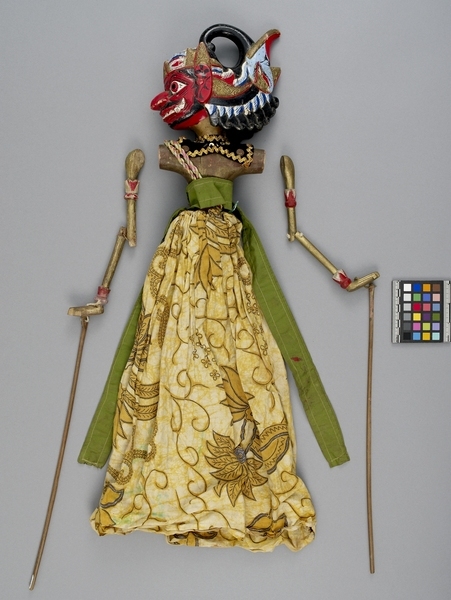Rod Puppet Item Number: Ib342 a-e from the MOA: University of British Columbia


Description
A three-dimensional male humanoid figure puppet. Has a large head and jointed arms attached to controlling rods. The red face is positioned straight forward and has bulging eyes with red irises, a large nose, facial hair (moustache, beard, sideburns), and details painted in black. Prominent white upper teeth with fangs extending from the top and the bottom row at each side. Wearing a Gelung supit urang headdress with diadem (jamang), sumping, Garuda Mungkur (short-tongued), and much hair from below headdress. The headdress is black, gold, red, blue, and white. Wide shoulders, a slim waist, and arms with ornaments at the wrist, and bicep in red. Skin is painted gold. Hands are held flat and bending back at the wrist. Braided hemp bandolier of green, yellow, and pink. Pink waistband and green wrapping suspended on both sides. Black velvet pentagon below waist (apron ?) with sequins, brocade, and a orange, and brown batik skirt.
History Of Use
Javanese puppetry as an art form probably developed by the 11th century. Wayang golek puppets of western Java appeared during the 16th century. Originally the plays depicted Javanese mythology, but after the Indian conquest of Java the Hindu epics, Ramayana and Mahabharata, were incorporated into the cycles, which comprise about 200 plays. A dalang (puppet master) performs the plays to celebrate important occasions, usually in three acts, with vocal and instrumental accompaniment. Typically they serve a moral and religious purpose, and more recently, one of political commentary. Brajamusti is a raden (prince), brother of King Arimba, allies of the Kurawa brothers in their unjust war against the good Pandawa brothers. This story appears in the Mahabharata cycle. He plays the role of a warrior.
Cultural Context
Theatrical performance.
Iconographic Meaning
Each puppet is characterized by it's wanda, a Javanese word which describes the specific mixture of elements of size, form, colour, ornamentation and carving. Red face, red irises, fangs, facial features indicative of an evil (kasar) character, although other features (headdress, batik skirt) suggest wealth or rank. Clothing rich; bandoleer and other aspects somewhat ostentatious. Headdress, double fangs, facial type identifies character as a particularly evil aspect of Brajamusti, a prince of the Mahabharata cycle.
Item History
- Made in Java, Indonesia
- Owned by Tradewind Antiques before March 15, 1983
- Received from Museum of Anthropology Shop Volunteers (Funding source) and Tradewind Antiques (Seller) on March 15, 1983
What
Who
- Culture
- Sundanese
- Previous Owner
- Tradewind Antiques
- Received from
- Museum of Anthropology Shop Volunteers (Funding source) and Tradewind Antiques (Seller)
Where
- Holding Institution
- MOA: University of British Columbia
- Made in
- Java, Indonesia
When
- Ownership Date
- before March 15, 1983
- Acquisition Date
- on March 15, 1983
Other
- Condition
- fair
- Accession Number
- 0886/0076